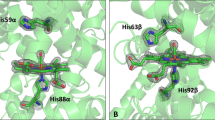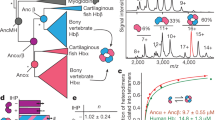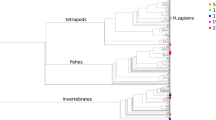Abstract
THE primary structure of the myoglobin of nine anthropoid primates is known from previous work on three ceboids, two cercopithecoids and four hominoids1,2. The most striking result of these investigations has been the nature of residue 110. With the exception of the cercopithecoids and hominoids this position is occupied by alanine in all mammalian myoglobins known, including those of the South American monkeys. In the Old World monkeys, however, residue 110 is serine, and in man and the three apes so far investigated it is a cysteine. It is noteworthy that two of the codons for Ala can change to codons for Ser by a single point mutation, and each of these can change to a codon for Cys by a further single point mutation. There seemed, therefore, to be an evolutionary sequence Ala → Ser → Cys at this position in myoglobin3. In the α chain of human haemoglobin and that of many other animals the homologous position is also occupied by cysteine4. The myoglobin residue at position 23 is also of particular interest among the primates, being serine in the gibbon and the monkeys investigated so far, whereas it is glycine in all other mammalian myoglobins for which the primary structure is known, including those of man, chimpanzee and gorilla.
This is a preview of subscription content, access via your institution
Access options
Subscribe to this journal
Receive 51 print issues and online access
$199.00 per year
only $3.90 per issue
Buy this article
- Purchase on Springer Link
- Instant access to full article PDF
Prices may be subject to local taxes which are calculated during checkout
Similar content being viewed by others
References
Romero-Herrera, A. E., Lehmann, H., Joysey, K. A., and Friday, A. E., Nature, 246, 389–395 (1973).
Romero-Herrera, A. E., Lehmann, H., and Fossey, D., Biochim. biophys. Acta, 393, 383–388 (1975).
Romero-Herrera, A. E., and Lehmann, H., Biochim. biophys. Acta, 278, 465–481 (1972).
Dayhoff, M. O., Atlas of Protein Sequence and Structure, 5 (The National Biomedical Research Foundation, Silver Spring, Maryland, 1972).
Delson, E., and Andrews, P., in Phylogeny of the Primates: a Multidisciplinary Approach (edit. by Luckett, W. P., and Szalay, F. S.), 405–446 (Plenum, New York, 1975).
Goodman, M., in Classification and Human Evolution (edit. by Washburn, S. L.), 203–234 (Aldine, Chicago, 1963).
Sarich, V. M., Proc. natn. Acad. Sci. U.S.A., 58, 142–148 (1967).
Doolittle, R. F., Wooding, G. L., Lin, Y., and Riley, M., J. molec. Evol., 1, 74–83 (1971).
Groves, C. P., in Gibbon and Siamang (edit. by Rumbaugh, D. M.), 1, 1–89 (Karger, Basel, 1972).
Schultz, A. H., in Gibbon and Siamang (edit. by Rumbaugh, D. M.), 2, 1–54 (Karger, Basel, 1973).
Andrews, P., and Groves, C. P., in Gibbon and Siamang (edit. by Rumbaugh, D. M.), 4, 167–218 (Karger, Basel, 1976).
Darga, L. L., Goodman, M., and Weiss, M. L., in Gibbon and Siamang (edit. by Rumbaugh, D. M.), 2, 149–162 (Karger, Basel, 1973).
Romero-Herrera, A. E., and Lehmann, H., Proc. R. Soc., B 186, 249–279 (1974).
Author information
Authors and Affiliations
Rights and permissions
About this article
Cite this article
ROMERO-HERRERA, A., LEHMANN, H., CASTILLO, O. et al. Myoglobin of the orangutan as a phylogenetic enigma. Nature 261, 162–164 (1976). https://doi.org/10.1038/261162a0
Received:
Accepted:
Issue Date:
DOI: https://doi.org/10.1038/261162a0
This article is cited by
-
Palatine fenestrae, the orangutan and hominoid evolution
Primates (1983)
-
The relationships of Sivapithecus and Ramapithecus and the evolution of the orang-utan
Nature (1982)
-
Evolution of the amino acid substitution in the mammalian myoglobin gene
Journal of Molecular Evolution (1980)
-
The location of DNA homologous to human satellite III DNA in the chromosomes of chimpanzee (Pan troglodytes), gorilla (Gorilla gorilla) and orang utan (Pongo pygmaeus)
Chromosoma (1977)
Comments
By submitting a comment you agree to abide by our Terms and Community Guidelines. If you find something abusive or that does not comply with our terms or guidelines please flag it as inappropriate.



